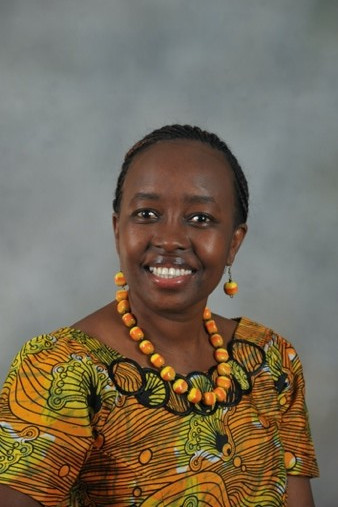GCLIE Plenary Speakers
 Kate Newman, Vice-President, World Wildlife Fund (US)
Kate Newman, Vice-President, World Wildlife Fund (US)
Topic: Reinventing the Road Ahead: forging a new path for linear infrastructure planning in Asia
As vice president for sustainable infrastructure and public sector initiatives, Kate Newman specializes in supporting large-scale conservation planning and policy development with a focus on promoting and enabling the global shift to sustainable and nature-based infrastructure. In her three decades with World Wildlife Fund (WWF), Kate has worked with colleagues around the world to facilitate the integration of cutting-edge conservation science into economic development through marine and terrestrial ecoregion planning, community-based conservation, protected area management, and conservation finance. Before coming to WWF, Kate worked in the Democratic Republic of the Congo (then called Zaire) for the US Agency for International Development. While there, she supported farm-to-market road, minihydropower, and rural health clinic development while strengthening civil society organizations. She started in Zaire as a secondary schoolteacher for the Peace Corps. She received a BA in anthropology from the University of Virginia and an MSc in environmental management from the University of London.
 Lucy Waruingi, Executive Director of the African Conservation Centre (Kenya)
Lucy Waruingi, Executive Director of the African Conservation Centre (Kenya)
TOPIC: Impacts of Linear Infrastructure in Eastern and other parts of Africa
Lucy Waruingi is the Executive Director of the African Conservation Centre (ACC) a Kenyan-based NGO working in East Africa with programs across themes of conservation science on emerging conservation issues, community based conservation to support initiatives that enhance local livelihoods in rich biodiversity areas., and mainstreaming biodiversity to influence planning and action at local, national and global level. Lucy has experience and a long interest in conservation policy and planning, with specialisation in Biodiversity Informatics to support interpretation of biological and environmental data for decision making. Currently she leads as a Co-PI on a WCMC-GCRF project that seeks to study the impact of large linear infrastructure on biodiversity in East Africa and engage decision makers on the same. She holds a Masters in Geographic Information Systems from Manchester Metropolitan University and is the chair of the Conservation Alliance of Kenya and a founder member of the Society for Conservation GIS, Kenya Chapter.
 Carme Rosell, Director, Minuartia (Spain)
Carme Rosell, Director, Minuartia (Spain)
Topic: Challenges and opportunities to wildlife and transport infrastructure in our progress towards European Green Deal goals
Carme is a senior research consultant who leads Minuartia and takes part in a research group at the University of Barcelona (UB). She is an elected member of the Infrastructure and Ecology Network Europe (IENE) Governance Board. She has lead over 80 projects on mitigation of human-wildlife conflicts particularly focused on wild boar, animal-vehicle collisions, design and monitoring of wildlife crossings and practice to enhance biodiversity in transport infrastructure, including works on roads, railways, airports and waterways. Carme co-authored the European Handbook ‘Wildlife and Traffic’, the ‘Handbook of Road Ecology’, the ‘Technical prescriptions for wildlife crossing and fence design’ and the ‘Guidelines for Maintenance of Ecological Assets on transport linear infrastructure’. She participates in several R&D projects undertaken by cooperating organisations from different European countries. Most notable are the ACTION COST 341 Habitat Fragmentation due to Transportation Infrastructure, the CEDR project SAFEROAD Safe Roads for Wildlife and People, and the recently launched HORIZON 2020 BISON on Biodiversity and Transport Infrastructure. Her research and teaching activities include collaboration on master’s degrees in Landscape Architecture at Polytechnic University of Catalonia and Ecological Restoration at UB. Carme is a passionate bridge-builder between the researcher and practitioner. She aims to develop shared language, understanding and cooperation towards mainstreaming biodiversity in the planning, design and operation of transport infrastructure.
 Fernanda Teixeira, Federal University of Rio Grande do Sul (Brazil)
Fernanda Teixeira, Federal University of Rio Grande do Sul (Brazil)
TOPIC: Linear infrastructure impacts and mitigation in Latin America
Fernanda Z. Teixeira is a postdoctoral researcher at the Ecology Graduate Program at the Federal University of Rio Grande do Sul in southern Brazil, working with ecological research projects at the Road and Railroad Ecology Group.
Fernanda has almost fifteen years of experience in road ecology research, with research and mitigation projects mainly involving road mortality and connectivity for different taxa. She is currently working on research projects related to the effects of roads and railways on wildlife, the effectiveness of mitigation measures, and the quality and effectiveness of environmental licensing.
She is currently involved in the creation of the Latin America and the Caribbean Transport Working Group (IUCN) and participating in the coordination committee of the Brazilian Network of Transport Ecology Specialists (REET-Brasil). She holds a master and a PhD in Ecology and previously was a postdoc at the Geomatics and Landscape Ecology Lab at Carleton University (Canada) and at the Environmental Analysis and Modeling Program / UFMG (Brazil).
 David Theobald, Conservation Scientist, Conservation Planning Technologies (US)
David Theobald, Conservation Scientist, Conservation Planning Technologies (US)
TOPIC: Measuring fragmentation of natural landscapes by North American linear infrastructure
Dave heads the EXP initiative at Conservation Planning Technologies. He has worked for nearly 30 years as a landscape ecologist and geographer to assess the patterns and trends of land use that emerge from socio-ecological systems operating at global to local scales. Dave applies his experience and expertise to inform connectivity and permeability modeling, conservation planning and proposed policy changes on natural resource sustainability, and landscape vulnerability assessments. He has used visualizations of landscape dynamics to compel policy makers, land managers, and the general public to conserve lands and waters. Through exercising collaborations, creating tools, and placing network science within a geographic context, Dave envisions a world of permeable and regenerative landscapes.
